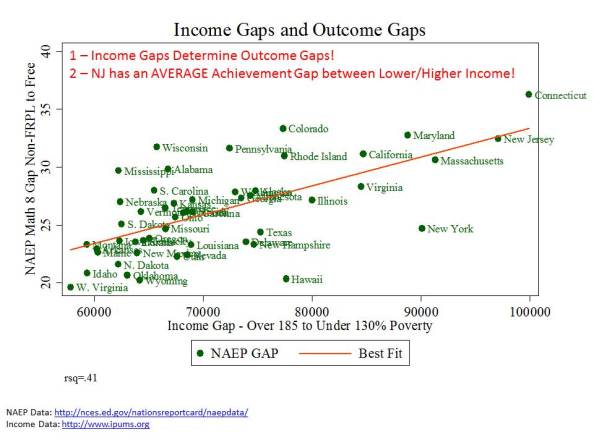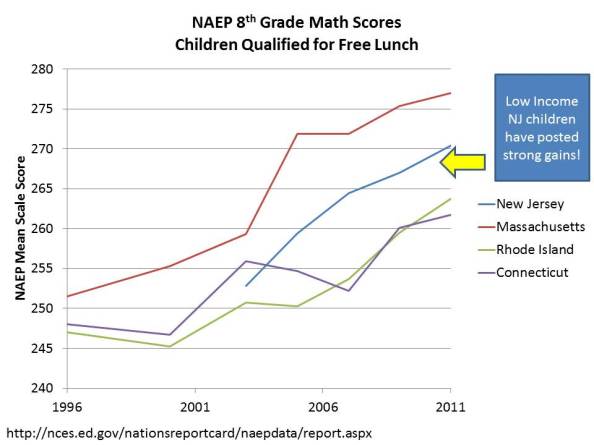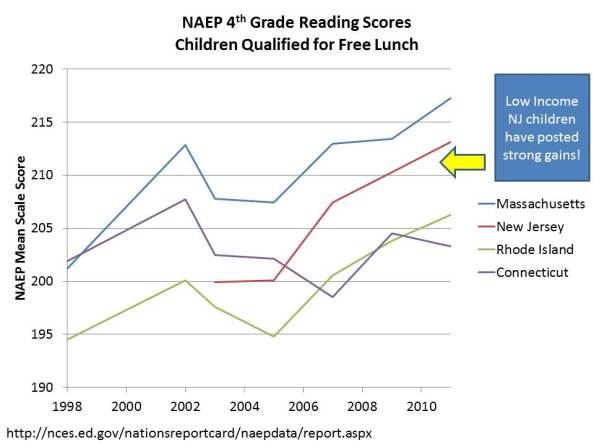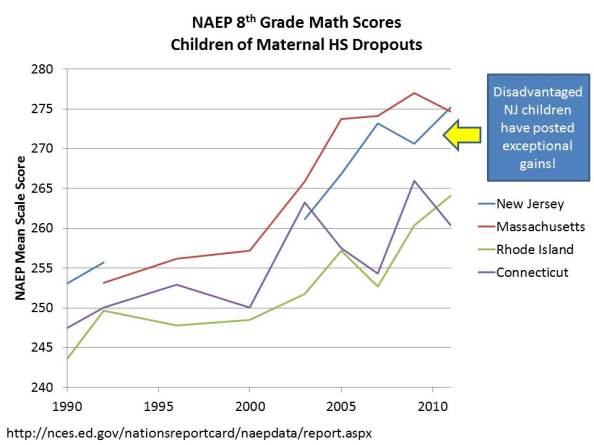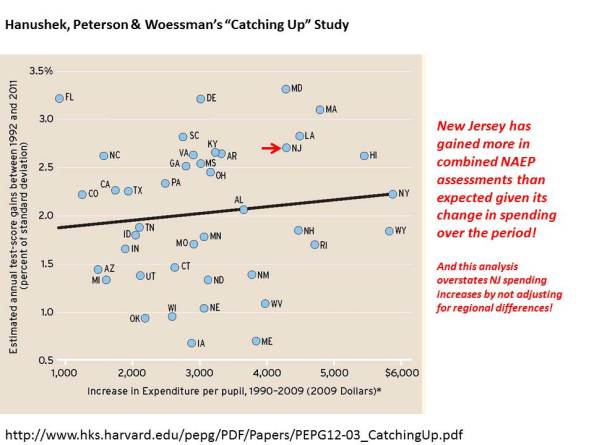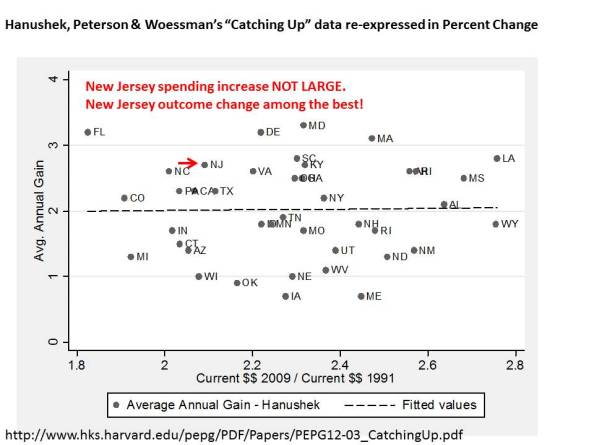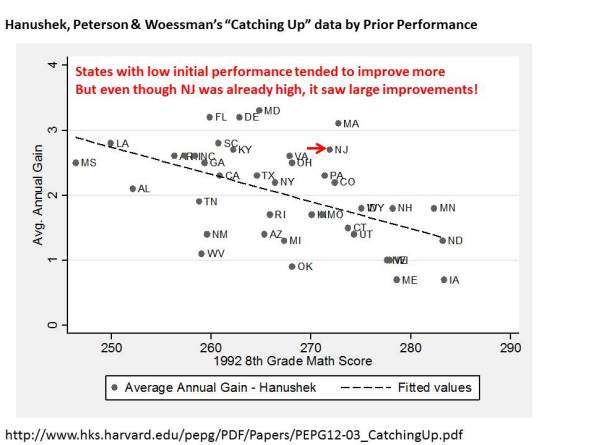Twisted Truths & Dubious Policies: Comments on the NJDOE/Cerf School Funding Report
Yesterday, we were blessed with the release of yet another manifesto (as reported here on NJ Spotlight) from what has become the New Jersey Department of Reformy Propaganda. To be fair, it has become increasingly clear of late, that this is simply the new model for State Education Agencies (see NYSED Propaganda Here), with the current US Dept of Education often leading the way.
Notably, there’s little change in this report from a) the last one or b) the Commissioner’s state of the schools address last spring.
The core logic of the original report remains intact:
- That NJ has a problem – and that problem is the achievement gap between low income and non-low income kids;
- That spending money on these kids doesn’t help – in fact it might just hurt – but it’s certainly a waste;
- Therefore, the logical solution to improving the achievement gap is to reduce funding to districts serving low income and non-English speaking kids and shift that funding to others.
Here’s a quick walk-through…
The Crisis?
The new report, like the previous, zeros in on the problem of New Jersey’s achievement gap between low income and non-low income kids. Now, the reason that the recent reports have focused so heavily on the achievement gap is that in the early days of this administration, the rhetoric was focused on the system as a whole being academically bankrupt. The simple response was to point out that NJ schools, by nearly any outcome measure stack up quite favorably against nearly any other state. So, they had to back off that rhetoric, and move to the achievement gap thing. Here’s one of the justifying statements in the current report.
“Likewise, on the 2011 administration of the National Assessment of Educational Progress, New Jersey ranked 50th out of 51 states (including Washington, D.C.) in the size of the achievement gap between high- and low-income students in eighth grade reading.”
Of course, as I’ve pointed out again and again, and will reiterate below, this is an entirely bogus comparison.
The Proposed Solution?
Like the previous funding report from last Winter, the primary recommendations in this new manifesto are to reduce funding adjustments for low income and non-English speaking kids, because we know they don’t need that funding and certainly couldn’t and obviously haven’t used it well. The report did back off from proposing one of the oldest tricks in the book for cutting aid to the poor – funding on average daily attendance – but likely backed off because they simply lack the legal authority to propose this change in this context and not out of any moral/ethical principle.
The Rationale?
The most bizarre section of the new report appears on the bottom of the second page. Here, the report’s author makes several bold, outlandish and unjustified and mostly factually incorrect statements. Further, little or no justification is provided for any of the boldly stated points. It’s nearly as ridiculous as The Cartel.
Here are two of my favorite paragraphs:
The conclusion is inescapable: forty years and tens of billions of dollars later, New Jersey’s economically disadvantaged students continue to struggle mightily. There are undoubtedly many reasons for this policy failure, but chief among them is thehistorically dubious view that all we need to do is design an education funding formula that would “dollarize” a “thorough and efficient system of free public school” and educational achievement for every New Jersey student would, automatically and without more, follow.” (emphasis added)
“Of course, schools must have the resources to succeed. To the great detriment of our students, however, we have twisted these unarguable truths into the wrongheaded notion that dollars alone equal success. How well education funds are spent matters every bit as much, and probably more so, than how much is spent. New Jersey has spent billions of dollars in the former-Abbott districts only to see those districts continue to fail large portions of their students. Until we as a state are willing to look beyond the narrow confines of the existing funding formula – tinkering here, updating there – we risk living Albert Einstein’s now infamous definition of insanity: doing the same thing over and over again and expecting a different result.”
First, I would point out that starting with the line “the conclusion is inescapable” is one of the first red flags that most of what follows will be a load of BS. But that aside… let’s take a look at some of these other statements. I’m not sure who the Commissioner thinks is advancing the “historically dubious view that all we need…blah…blah… blah… dollarize … blah… blah” but I would point out that the central issue here is that a well organized, appropriately distributed, sufficiently funded state school finance system provides the necessary underlying condition for getting the job done – achieving the desired standards, etc. (besides nothing could ever equal the reformy dubiousness of this graph… or these!) .
This isn’t about arguing that money in and of itself solves all ills. But money is clearly required. It’s a prerequisite condition. More on that below. This claim that others are advancing such an historical dubious view is absurd. Nor is it the basis for the current state school finance system, or the court order that led to the previous (not current) system! [background on current system here]
Equally ridiculous is the phrase about these “unarguable truths.” Again, when I see a phrase like this, my BS detector nearly explodes. Again, I’m not sure who the commissioner thinks is advancing some “wrongheaded notion” that “dollars alone equal success,” but I assure you that while dollars alone don’t equal success, equitable and adequate resources are a necessary underlying condition for success.
Indeed, the current state school finance system is built on attempts to discern the dollars needed to providethe necessary programs and services to meet the state outcome objectives [I'll set aside the junk comparisons to Common Core costs listed in the report for now]. But the focus isn’t/wasn’t on the dollars, but rather the programs and services – which, yes… ultimately do have to be paid for with… uh… dollars.
Under the prior Abbott litigation and resulting funding distributions, the focus was entirely on the specific programs and services required for improving outcomes of children in low income communities (early childhood education programs, adequate facilities, etc.). In fact, that was one of the persistent concerns among Abbott opponents… that the programs/services must be provided under the court mandate, regardless of their cost (not that the dollars must be provided regardless of their use) and in place of any broader, more predictable systematic formula. So, perhaps the answer is to go back to the Abbott model?
Ultimately, to establish a state school finance formula (which is a formula for distributing aid), you’ve got to “dollarize” this stuff. But that doesn’t by any stretch of the imagination lead to the assumption that the dollars create – directly – regardless of use – the outcomes. That’s just ridiculous. And the report provides no justification behind its attack on this mythical claim.
In fact, these statements convey a profound ignorance of even the recent history of school finance in New Jersey.
The Reality!
Now that I’m done with that, let’s correct the record on a few points.
New Jersey has an “average” achievement gap given its income gap
I’m not sure how many times I’ll have to correct the current NJDOE and its commissioner on their repeated misrepresentation of NAEP achievement gap data. This is getting old and it’s certainly indicative that the current administration is unconcerned with presenting any remotely valid information on the state of New Jersey schools. Given what we’ve seen in previous presentations I guess I shouldn’t be surprised.
In any case, here’s my most recent run of the data comparing income gaps and NAEP outcome gaps. Across the horizontal axis in this graph is the difference in income between those above the reduced lunch income threshold and those below the free lunch income threshold. New Jersey and Connecticut have among the largest gaps in income between these two groups. Keep in mind that the same income thresholds are used across all states, despite the fact that the cost of comparable quality of life varies quite substantially (nifty calculator here). On the vertical axis are the gaps in NAEP scores between the two groups.
Figure 1. Income Gaps and Achievement Gaps
As we can see, states with larger gaps in income between the groups also have larger gaps in scores between the two groups. Quite honestly, this is not astounding. It’s dumb logic. And that’s why it’s so inexcusable for Cerf & Co. to keep returning to this intellectually & analytically dry well.
Most importantly, NJ’s gap is right on the line. That is, given its income gap, NJ falls right where we would expect- on the line. NJ’s income related achievement gap is right in line with expectations!
Is that good enough? Well, not really. There’s still work to be done. But the bogus claim that NJ has the 2nd largest achievement gap has to stop.
New Jersey has posted impressive NAEP gains given its spending increases
Now let’s take a look at how disadvantaged kids in NJ have actually done on a few of the NAEP tests in recent years when compared to disadvantaged kids in similar states in the region. The pictures pretty much tell the story.
Figure 2. NAEP 8th grade Math for Children Qualified for Free Lunch
Figure 3. NAEP 4th grade Reading for Children Qualified for Free Lunch
Figure 4. NAEP 8th Grade Math for Children of Maternal HS Dropouts
Even Eric Hanushek’s recent data make NJ look pretty darn good in terms of NAEP gains achieved relatively to additional resources provided!
Figure 5. Relationship between Change in Per Pupil Spending and Overall NAEP Gain
Figure 6. Relationship between Change in % Spending per Pupil and Overall NAEP Gain
Figure 7. Relationship between Starting Point and Gain over Time
For more on these last few slides and the data from which they are generated, see this post.
Arguably, given these results, doing the same thing over and over again and expecting the SAME result might be entirely rational!
Money Matters & Equitable and Adequate Funding is a Necessary Underlying Condition for Success
Finally, a substantial body of literature exists to refute the absurd rhetoric and policy preferences of the NJDOE school funding report – most specifically the veiled assertion that reducing funding to low income children is the way to reduce the achievement gap.
In a recent report titled Revisiting the Age Old Question: Does Money Matter in Education? I review the controversy over whether, how and why money matters in education, evaluating the current political rhetoric in light of decades of empirical research. I ask three questions, and summarize the response to those questions as follows:
Does money matter? Yes. On average, aggregate measures of per pupil spending are positively associated with improved or higher student outcomes. In some studies, the size of this effect is larger than in others and, in some cases, additional funding appears to matter more for some students than others. Clearly, there are other factors that may moderate the influence of funding on student outcomes, such as how that money is spent – in other words, money must be spent wisely to yield benefits. But, on balance, in direct tests of the relationship between financial resources and student outcomes, money matters.
Do schooling resources that cost money matter? Yes. Schooling resources which cost money, including class size reduction or higher teacher salaries, are positively associated with student outcomes. Again, in some cases, those effects are larger than others and there is also variation by student population and other contextual variables. On the whole, however, the things that cost money benefit students, and there is scarce evidence that there are more cost-effective alternatives.
Do state school finance reforms matter? Yes. Sustained improvements to the level and distribution of funding across local public school districts can lead to improvements in the level and distribution of student outcomes. While money alone may not be the answer, more equitable and adequate allocation of financial inputs to schooling provide a necessary underlying condition for improving the equity and adequacy of outcomes. The available evidence suggests that appropriate combinations of more adequate funding with more accountability for its use may be most promising.
While there may in fact be better and more efficient ways to leverage the education dollar toward improved student outcomes, we do know the following:
Many of the ways in which schools currently spend money do improve student outcomes.
When schools have more money, they have greater opportunity to spend productively. When they don’t, they can’t.
Arguments that across-the-board budget cuts will not hurt outcomes are completely unfounded.
In short, money matters, resources that cost money matter and more equitable distribution of school funding can improve outcomes. Policymakers would be well-advised to rely on high-quality research to guide the critical choices they make regarding school finance.
Regarding the politicized rhetoric around money and schools, which has become only more bombastic and less accurate in recent years, I explain the following:
Given the preponderance of evidence that resources do matter and that state school finance reforms can effect changes in student outcomes, it seems somewhat surprising that not only has doubt persisted, but the rhetoric of doubt seems to have escalated. In many cases, there is no longer just doubt, but rather direct assertions that: schools can do more than they are currently doing with less than they presently spend; the suggestion that money is not a necessary underlying condition for school improvement; and, in the most extreme cases, that cuts to funding might actually stimulate improvements that past funding increases have failed to accomplish.
To be blunt, money does matter. Schools and districts with more money clearly have greater ability to provide higher-quality, broader, and deeper educational opportunities to the children they serve. Furthermore, in the absence of money, or in the aftermath of deep cuts to existing funding, schools are unable to do many of the things they need to do in order to maintain quality educational opportunities. Without funding, efficiency tradeoffs and innovations being broadly endorsed are suspect. One cannot tradeoff spending money on class size reductions against increasing teacher salaries to improve teacher quality if funding is not there for either – if class sizes are already large and teacher salaries non-competitive. While these are not the conditions faced by all districts, they are faced by many.
It is certainly reasonable to acknowledge that money, by itself, is not a comprehensive solution for improving school quality. Clearly, money can be spent poorly and have limited influence on school quality. Or, money can be spent well and have substantive positive influence. But money that’s not there can’t do either. The available evidence leaves little doubt: Sufficient financial resources are a necessary underlying condition for providing quality education.
There certainly exists no evidence that equitable and adequate outcomes are more easily attainable where funding is neither equitable nor adequate. There exists no evidence that more adequate outcomes will be attained with less adequate funding. Both of these contentions are unfounded and quite honestly, completely absurd.
Related sources:
Baker, B.D. (2012) Revisiting the Age Old Question: Does Money Matter in Education. Shanker Institute.http://www.shankerinstitute.org/images/doesmoneymatter_final.pdf
Baker, B.D., Welner, K. (2011) School Finance and Courts: Does Reform Matter, and How Can We Tell? Teachers College Record 113 (11) p. –
This blog post has been shared by permission from the author.
Readers wishing to comment on the content are encouraged to do so via the link to the original post.
Find the original post here:
The views expressed by the blogger are not necessarily those of NEPC.
